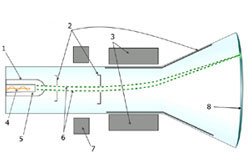HAZARDOUS WASTE
Hazardous waste is that which poses substantial or potential threats to public health or the environment. A product in corporates, business establishments, government agencies and households that is ignitable, corrosive, reactive or toxic.
E-waste contains a number of toxic substances such as
Lead and cadmium in circuit boards
Lead oxide and cadmium in monitor cathode ray tubes (CRTs)
Mercury in switches and flat screen monitors
Cadmium in computer batteries
polychlorinated biphenyls (PCBs) in older capacitors and transformers
Brominated flame retardants on printed circuit boards, plastic casings, cables and polyvinyl chloride (PVC) cable insulation that release highly toxic dioxins and furans when burned to retrieve copper from the wires
Cell phones and computers
Refrigerant containing appliances such as a refrigerator, air conditioner or dehumidifier.
These products are categorized as wastes which (because of its quantity, concentration or characteristics) could be hazardous to human health or the environment when improperly treated, stored, transported or disposed. All such wastes of a polluting nature posing a health or environmental risk is hazardous waste that has to be treated in an environment friendly manner.

crt tubeCathode Ray-tube: CRT monitors and TVs contain and average of 4 pounds of lead each. Excessive lead and other toxins pose a problem in landfills because they can leach into groundwater or, in the case of a lined landfill, force expensive leachate treatment. In combustors, the lead winds up on the ash residue, which in turn disposed of in landfills.Lead exposure ahs been linked with learning disabilities, behavioural problems and at very high levels, seizures, coma and even death.
Batteries:
Lead-Acid/Automotive Batteries:
Lead batteries are this country’s principal source of power for automobiles, trucks, motorcycles, boats, forklifts, golf cats, lawn and garden tractors, and wheelchairs. These heavy, rectangular batteries contain sulphuric acid, which can burn skin on contact.
Alkaline Batterie:
Alkaline batteries are standard household batteries. They are used in product from walkmans and clocks, to smoke detectors and remote controls. Since -1994, most types contain no added mercury or only contain trace amounts. These batteries are market “no added mercury” or may by market with a green tree logo.
Button Batteries:
These batteries are named for being small round and silver-colored. They are most commonly found in watches and hearing aids. Many button batteries contain mercury of silver oxide, both metal that are toxic to humans when inhaled or ingested.
Nickel-Cadmium Rechargeable Batteries:
These batteries are marked “Rechargeable” and are found in many products including: cell phones, cordless phones, laptops, power tools, camcorders and remote controlled toys. NiCads contain cadmium, a metal that is toxic to humans when inhaled or ingested.
Lithium Batteries:
These batteries are mainly used in computer, camcorders, laptop and cameras, lithium ignites when in contact with water and has been notorious for causing serious fires.
Printers:
Most printer cartridges are easily recycled, refilled or re-built. But printer vendors sell the printer cheap, and make their real money selling supplies. The “right” environmental solution is to sell new cartridges with a postage paid mailer for returning the old one. Some advanced companies, such as Hewlett-Packard, have been known to do this especially for laser printers.
Old Refrigerators, Heat Pumps and Air Conditioners:
Mostly, old refrigeration equipment contains Freon, a chemical known as a Chlorinated Fluorocarbon or “CFC” Each molecule of a CFC can destroy over 100,000 molecules of the earth’s protective ozone coating, leading increased risk of sunburn, cataracts and skin cancer for the entire population of the planet (human and animal)
Motor Oil:
Used motor oil contains heavy metals and other toxic substances and is considered hazardous waste. One quart of oil can kill fish in thousands of gallous of water. Motor oil containers should mention the danger of used oil to humans and the environment.
Paper:
Most types of paper can be recycled. Newspapers have been recycled profitably for decades and recycling of other papers is rising. Virgin paper pulp prices have soared in recent years prompting construction of more plants capable of using waste paper. They key to recycling is collecting large quantities of clean, well-sorted, uncontaminated and dry paper.
Glass, Steel Aluminum Cans and Foil:
Glass, steel and aluminum are easy to recognize and recycle. Glass bottles must not be mixed with other types of glass such as windows, light bulbs, mirrors, glass tableware, Pyrex or auto glass. Ceramics contaminate glass and are difficult to sort out. Clear glass is the most valuable. Mixed color glass in near worthless and broken glass is hard to sort out.
Plastic:
With a little bit of care, plastic can be recycled. The awareness of recycling plastic is increasing rapidly. However, there is one drawback. Different types of plastics must not be mixed together while recycling. This can ruin the entire process of recycle.
